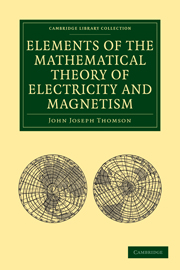Book contents
- Frontmatter
- PREFACE TO FIRST EDITION
- PREFACE TO THE SECOND EDITION
- PREFACE TO THE THIRD EDITION
- PREFACE TO THE FOURTH EDITION
- Contents
- CHAP. I General Principles of Electrostatics
- CHAP. II Lines of Force
- CHAP. III Capacity of Conductors. Condensers
- CHAP. IV Specific Inductive Capacity
- CHAP. V Electrical Images and Inversion
- CHAP. VI Magnetism
- CHAP. VII Terrestrial Magnetism
- CHAP. VIII Magnetic Induction
- CHAP. IX Electric Currents
- CHAP. X Magnetic Force due to Currents
- CHAP. XI Electromagnetic Induction
- CHAP. XII Electrical Units: Dimensions of Electrical Quantities
- CHAP. XIII Dielectric Currents and the Electromagnetic Theory of Light
- CHAP. XIV Thermoelectric Currents
- CHAP. XV The Properties of Moving Electric Charges
- INDEX
CHAP. X - Magnetic Force due to Currents
Published online by Cambridge University Press: 07 September 2010
- Frontmatter
- PREFACE TO FIRST EDITION
- PREFACE TO THE SECOND EDITION
- PREFACE TO THE THIRD EDITION
- PREFACE TO THE FOURTH EDITION
- Contents
- CHAP. I General Principles of Electrostatics
- CHAP. II Lines of Force
- CHAP. III Capacity of Conductors. Condensers
- CHAP. IV Specific Inductive Capacity
- CHAP. V Electrical Images and Inversion
- CHAP. VI Magnetism
- CHAP. VII Terrestrial Magnetism
- CHAP. VIII Magnetic Induction
- CHAP. IX Electric Currents
- CHAP. X Magnetic Force due to Currents
- CHAP. XI Electromagnetic Induction
- CHAP. XII Electrical Units: Dimensions of Electrical Quantities
- CHAP. XIII Dielectric Currents and the Electromagnetic Theory of Light
- CHAP. XIV Thermoelectric Currents
- CHAP. XV The Properties of Moving Electric Charges
- INDEX
Summary
201. It was not known until 1820 that an electric current exerted any mechanical effect on a magnet in its vicinity. In that year however Oersted, a Professor at Copenhagen, showed that a magnet was deflected when placed near a wire conveying an electric current.
When a long straight wire with a current flowing through it was held near the magnet, the magnet tended to place itself at right angles both to the wire and the perpendicular let fall from the centre of the magnet on the wire.
The lines of magnetic force due to a long straight wire may be readily shown by making the wire pass through a hole in a card-board disc over which iron filings are sprinkled. When the disc is at right angles to the wire, the iron filings will arrange themselves in circles when the current is flowing; these circles are concentric, having as their centre the point where the wire crosses the plane of the disc.
The connection between the direction of the current and that of the magnetic force is such that if the axis of a right-handed screw (i.e. an ordinary corkscrew) coincides with the direction of the current, then if the screw is screwed forward into a fixed nut in the direction of the current the magnetic force at a point P due to the current is in the direction in which P would move if it were rigidly attached to the screw.
- Type
- Chapter
- Information
- Elements of the Mathematical Theory of Electricity and Magnetism , pp. 329 - 386Publisher: Cambridge University PressPrint publication year: 2009First published in: 1895



